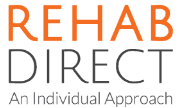



Steve’s story: life before the Rehab programme
Steve’s life was changed instantly when he was diagnosed with stage 4 prostate cancer. As a result of his diagnosis, his general health started to deteriorate, and pain became normal. It wasn’t long after his cancer diagnosis that Steve decided his pain must be related, and he accepted that this was his future.
“I thought the pain was the cancer. So, I basically thought there’s nothing I can do and it’s something I’ve got to live with.”
Speaking with his Oncologist, Steve discovered his cancer was not close to any nerves or triggers for pain, therefore it was highly unlikely that his pain was related to the cancer after all. Weeks after discussing what could be causing his pain and being prescribed painkillers to help him manage his condition, Steve saw an advert in his local GP surgery stating, ‘you don’t have to live with pain’, to which he thought – “I’m going to sign up for that.”
The beginning
We first met Steve after he enquired about our Chronic Pain Service. He was looking for a solution which would both reduce the pain he was experiencing, bring back some of his regular routine and allow a return to, as close as possible, normality.
He was assigned a Health and Wellbeing Coach to begin his journey through the programme. The first steps were to take Steve through a full assessment, to agree some personal goals, understand the value and safety of his exercises and start a journal of his progress. This process and all the connected resources are a part of our normal approach when working with new patients.
Steve’s Health & Wellbeing Coach recalls “When I first spoke to Steve he had a calm, measured approach towards the programme and was willing to try. He was open and relayed a lot of information to me about his diet, sleep and exercise that he was currently doing.”
The transparency between Steve and his Health and Wellbeing Coach established a solid foundation based on trust, rapport and consistent support. This allowed them to work collaboratively towards his health and wellbeing goals. Steve’s willingness to be open about his lifestyle and habits demonstrated a firm commitment to making meaningful positive change and that he was willing to take some responsibility for his journey of recovery.
The turning point
After just 2 weeks of the programme Steve recalls “I went from having 8 pain killers a day to 5 pain killers in a week, just because of the exercises. I was more supple. I was happier in myself… What it did for me was unbelievable.”
From this point onwards Steve noticed continual improvement. “I began to see and feel a real difference around week 3. The best part was knowing I wasn’t alone, that somebody was there to help me. I had encouragement from my Health and Wellbeing Coach, and I knew I had an hour every week that I could sit and talk with her, to focus on my physical and mental health.”
Health and Wellbeing Coach says “Steve was also doing home exercises and stretching twice a day. He will say now that he was not sure how he thought he would benefit by doing the walking and exercises, but he kept doing them anyway. By week 4, there was a noticeable turning point for Steve. Things were looking very positive, and changes were starting to happen. Steve said that he wasn’t experiencing any pain and that he knew the exercises were helping him.”
An alternative to medication for chronic pain
Our pain management program employs the biopsychosocial model, which considers all aspects of a patient’s life and lifestyle, to assist them in managing their pain more effectively. This model emphasises the interconnection of the biological, psychological, and social factors, in influencing pain perception and experience. new goals from there”.
Steve highlighted “For me having clear, achievable goals worked really well. I have something to aim for and a new challenge every week… I don’t do well with drugs. I wanted to get away from them a bit, and then a fortnight in I thought – hold on, I’m not taking the co-codamol. I’m not taking my paracetamol. It really works.”
The first goal Steve set himself was to walk to the local church and back which he successful did. He was then surprised when his Health and Wellbeing Coach asked him what his next goal was going to be.
Steve decided; “I’m going to visit my son… and I want to be able to walk around Cardiff, and not be a hinderance to anybody… And I did! It was fantastic. And then we kept going on to new goals from there”.
Goal setting involves establishing specific, measurable objectives that you aim to achieve within a set timeframe. It helps to identify what the patient wants to accomplish and breaks it down into manageable steps. We use “pacing” to assist patients to achieve their goals. Pacing refers to the rate of speed at which a patient progresses towards their objectives. It’s a key element of the programme, so to hear that Steve found these aspects significant in his daily life is particularly notable. It’s important to find a balance between pushing yourself forward and allowing yourself enough time to rest, reflect and recover.
Measuring Progress
Before starting the programme, Steve couldn’t get up off the floor or lay on his back without pain. After completing a routine of daily exercises, it began to get easier to do this and his pain reduced. Steve had to push himself and “put the effort in”, but he said “Every day it got easier, I would start with the easy exercises that I knew I could complete and work my way up to the hard ones. You just have to find a way to fit it into your day and once you do, you won’t look back. You have to get through the first 2/3 weeks. It does get easier…I am not young, I am 63, I’m not meant to be supple! But I am much more supple than I used to be that’s for sure!”
To help understand how patients progress on the programme, Health and Wellbeing Coaches request each patient complete a journal to discuss on their weekly calls. “From week 3, I could see an improvement, and B [Health and Wellbeing Coach] would ask how I was doing. Some days it was ‘never mind’, some days were ‘well done’, but I felt like I had someone to help me do it”.
As well as providing morale support, Health and Wellbeing Coaches, alongside the journal, provide clear milestones for reflection to support goal setting. An example of how this helps is that Steve could clearly identify week 3 as a turning point for his progress, despite speaking with us several weeks after the 12-week programme concluded. Steve continues to use the journal to map his progress at the time of writing.
For even clearer, quantitative results, we also deploy a validated outcome measure: PSEQ (Patient Self Efficacy Questionnaire).
The PSEQ scores are a benchmark to determine improvements throughout the programme, measuring a patients’ confidence levels in managing their pain. It is important to note that scores are individual benchmarks, and every patient is different.
Patients score themselves from 0 (not at all confident) to 6 (completely confident) against a range of criteria. This is then translated to a score of between 0 and 60, where a score of 40 or above shows the patient as confident in managing their pain. A patient finishing the programme with a score above 40 shows they are more likely to self-manage long-term.
In just 4 weeks Steve’s PSEQ score went from 37/60 to 54/60.
Throughout the programme, Steve has demonstrated exceptional commitment to his personal growth and wellbeing. The significant increase in Steve’s PSEQ score reflects not only his willingness to participate in the programme and his increased confidence in managing and coping with his pain.
“It’s given me part of my life back”
After Steve completed the programme, we had a discussion to speak further about his experience. He informed us “I’ll definitely continue the exercises. I’m all together better”.
Steve’s advice to others was “I would have struggled to do the radiotherapy without the programme. It was painful to lay on my back but the exercises I have continued to do have enabled me to lay on my back for quarter of an hour and be ok. If you miss a day, you do feel different. I couldn’t sit or stand and now I can sit comfortable for an hour with my mate. The programme has allowed me to get back to normality.”
After Steve completed the programme, his Health and Wellbeing Coach said “On each call, we spoke about what goals he would like to set himself as I thought it was important for him to feel that sense of achievement. We started off with talking about walking to his local church. He was true to his word by sticking to his goals and as hoped, he was proud of what he had achieved. The next goal he wanted to extend his walks and throughout the programme that is what he did. By completing his goals, he started to believe in himself and push himself further each time.”
“He was so thankful for being the programme and said he wanted to tell everyone he could about his experience and advise them to go forward with it if they had chronic pain.”
“Towards the end, Steve had an appointment at the hospital coming up for his radiotherapy results. He said that he was really nervous and worried about it and had not been doing his exercises and then started to experience pain again. After this, Steve had his results and it was all positive, so Steve then went on to saying how much he let his worries stop him from doing the exercises. Steve was feeling so much more positive after our last phone call as he understood that he needed to continue the exercises and achieving his goals.”
“Overall, Steve was very pleased with the pain management service and thanked everyone who was involved. Moving forward he agreed that he would like to continue with his routine and staying positive in every day-to-day life as this is something that helps his pain.”
It is important to note that scores are individual benchmarks, and every patient is different. While our goal is always to maximise this score, we also want to ensure that the patient feels their objectives have been met. In this case we feel that Steve has reached his objectives and has achieved a very positive outcome with his PSEQ score while he continues to manage his pain following his completion of the programme.
Our team spoke with Steve following his time on the programme. Steve has given permission to use his name and relevant information for the purpose of this publication.
1 May 2024
Copyright @ 2025 Rehab Direct - All Rights Reserved
Privacy Policy - Sitemap - Modern Slavery Statement